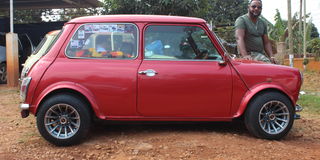Prime
Restoring my 1976 Austin Mini is a passion – Tumaini

Tumaini says he used 100 litres of fuel for the journey from Kenya to Kampala, Uganda. PHOTOs/Roland D. Nasasira
What you need to know:
Tumaini says at some point he stopped counting the cost of the many parts needed to make his car road worthy.
When I meet Tumaini Muthiga in Ntinda, Kampala, he is in the company of his friends with whom they drove from Kenya to Uganda for a weekend getaway trip. There are different classes and brands of cars and one of them is Tumaini’s 1976 Austin Mini.
Looking at it closely, it is not only the smallest but it has the lowest ground clearance. A single door, you would mistake it for a two-seater but it can comfortably seat four, including the driver. The only downside here is that the seats at the rear are smaller compared to the driver’s and co-driver’s. The dashboard is a beautiful blend of polished wood, leather and shiny plastic.
Until early 2008, Tumaini’s Austin Mini was just a shell, being used as a chicken shelter before he started restoring it. He carried out an engine overhaul to replace parts such as piston rings, crank shafts, water pump, oil and fuel pumps.
The initial fuel tank would carry only 20 litres of fuel, a capacity that was upgraded to 30 litres during restoration. He also replaced the suspension bushes, tyrod ends, wheels and wheel nuts, fitting it with light emitting diode (LED) lights for better and brighter night driving experiences and many other parts. Externally, rebuilding the body included massive panel beating since the car had developed a lot of rust as a result of being parked in the junkyard for a long time.
“I would record all the rebuilding expenditures but along the way, I lost track and threw away the receipts because there was much to service with a lot of money to spend. It ceased to be something I could put a cost to but rather a passion,” Tumaini says.
Exhibition
Running on arguably the smallest petrol engine of only 850cc, Tumaini repaints the Austin Mini every year in preparation for the annual Concours d’elegance where it has been the best car in the Mini Cooper cars under 1000cc category for seven years. According to concourskenya.com, the concours d’elegance is the classiest event in the Kenya Motor Sport Federation and is attended by more than 10,000 people. The centre piece is the judging of 70 classic and vintage cars and 40 motorcycles under regulations approved by the Kenyan Motor Sport Federation (KMSF).
Performance
Throughout the more than 600 kilometre journey from Kenya to Kampala, Tumaini did not experience any mechanical problems. In terms of fuel consumption, the mileage per litre is sometimes challenging to estimate because it is entirely dependent on the rate of acceleration, which is also dependent on the terraine. Consumption on a flat and straight surface is different from driving uphill. According to Tumaini, he used 100 litres of fuel for the journey from Kenya to Kampala, Uganda.
Repair
During restoration, Tumaini replaced the seats with customised ones, with a monogram of his name. Apart from seats, customising is an aspect that is unique to every Mini Cooper, depending on what the owner wants. For example, Tumaini’s wheelbase runs on 12-inch rims while some of his friend’s Mini Coopers run on size 13 and 14.
“For this trip and any other long distances, I use rim size 12 because they are lighter and faster compared to 14 or 17. When I am driving in Nairobi, I use size 13 because it is heavy and makes the car stable. Also, since it has a small engine size, I do not have to worry about fuel consumption,” Tumaini says.
“One downside, however, is its low ground clearance, making it impractical off-road. For example, in Uganda, I avoided using Jinja Road which tends to be a bit bumpy and instead used Kayunga Road. Although some sections of this road were also bumpy, with cautious driving, I was able to make it through,” Tumaini adds.
Service and maintenance
One of the keys to keeping the Austin Mini in good condition is having your eyes glued to the temperature gauge. This is because the inner engine parts are quite compact with many small parts that are capable of exposing the engine to overheating. To prevent overheating, Tumaini drives at the right speed, while avoiding hard acceleration, especially when driving uphill.
This is coupled with carrying out timely service, especially replacing engine oil after every 5,000km or whenever required and advised by the mechanic. The coolant or water in the radiator and the fans have to be at their functional best at all times.
“I mainly drive it at the weekend and I do minor service twice a year. The beauty about these cars is they are admired by enthusiasts of all ages wherever I drive. Much as motorcyclists are reckless, they keep a distance from the car and this keeps me out of the garage to fix dents or scratches,” Tumaini concludes.
Fitted with chrome side mirrors and an original mini injection engine, when there is need for spare parts, Tumaini sources for them from Mini Spares, (minispares.co.uk), a spare parts dealer shop in the United Kingdom, from where he directly imports them.
The oil crisis sparked the idea
During the Second World War, Britain was in control of the Suez Canal, which served as an important source of oil, but this changed during the so called Suez crisis in 1956. The loss of British sovereignty led not only to a political defeat but also to an oil crisis.
For Alec Issigonis it was the chance to prove himself. The task; a car with lots of space inside with minimum dimensions outside, seats for four passengers, impeccable driving characteristics, superior fuel economy, and a very affordable price. And the result was the creation of the Mini.




